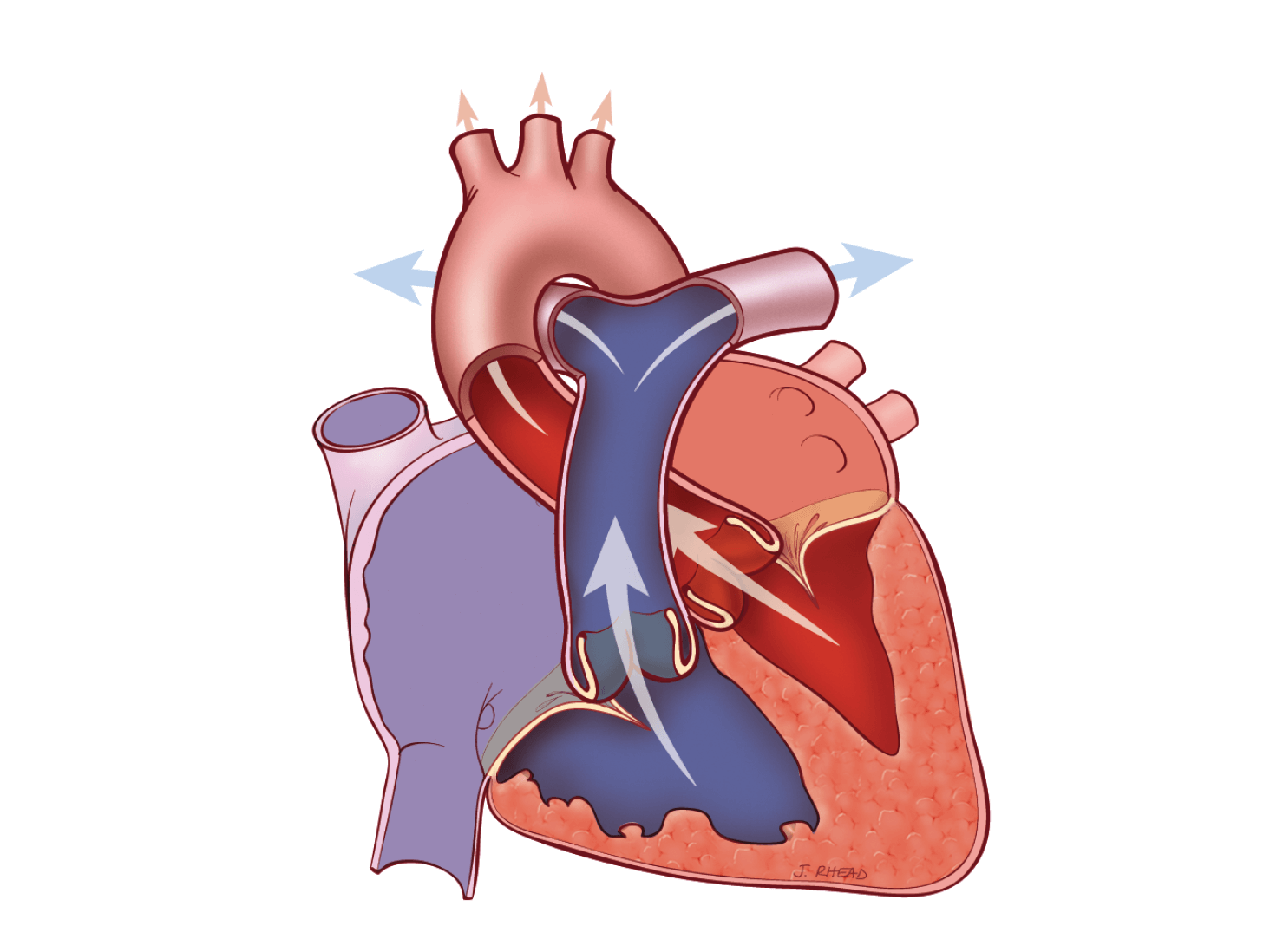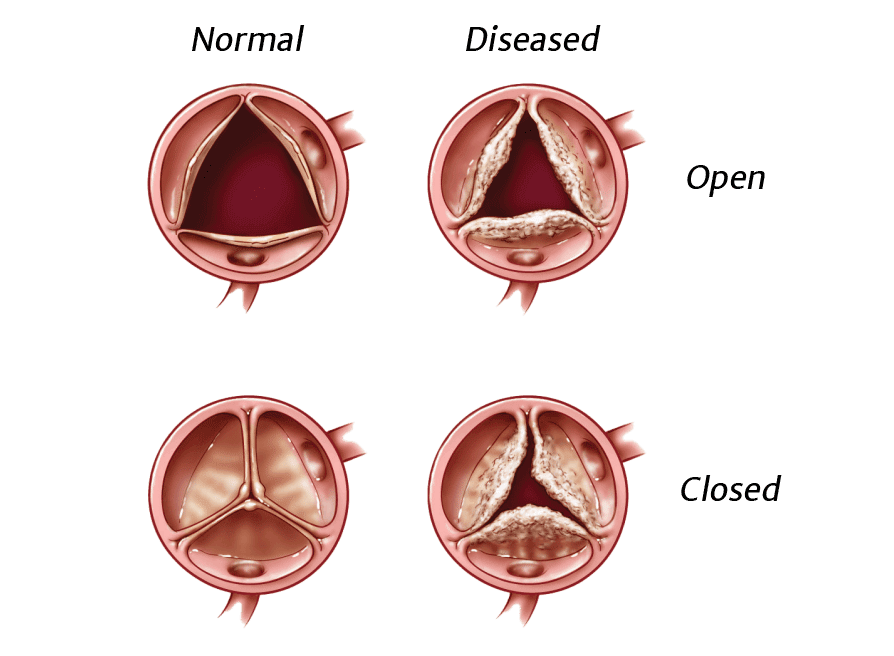
Transcatheter valves
Transcatheter aortic valve replacement (TAVR) is a less invasive approach to aortic valve replacement compared to open-heart surgery.

The heart is a muscular organ located in the center of the chest between the lungs. Your heart is about the size of your two hands when they are clasped together. The heart is a sophisticated pump, providing blood flow to all of the cells, tissues and organs in your body.
The heart contains four chambers. The heart pumps blood by contracting (squeezing blood out of its chambers) and relaxing (allowing blood to enter its chambers). The two upper chambers are called the atria. They receive blood returning from the body through veins. The two atria contract with only a small amount of force, sending the blood to the ventricles; the ventricles are the muscular, lower chambers of the heart. The ventricles contract with greater force, delivering blood to the body via your arteries. The right ventricle pumps blood to the lungs. Of all the chambers in the heart, the left ventricle does the greatest amount of work. Powerful contraction of the left ventricle sends oxygen-rich blood to all of the body’s organs.
The heart also has four valves. Their purpose is to ensure that blood flows only in one direction. The heart’s valves open at the appropriate times to allow forward flow of blood, then close to prevent back-flow of blood. The mitral and tricuspid valves control the flow of blood from the atria to the ventricles. The aortic and pulmonic valves control the flow of blood out of the ventricles. The image below shows the chambers and valves of the heart.

The purposes of blood are to deliver oxygen and nutrients to tissues and organs and to carry away waste products. There are actually two loops of circulation in the body.
The first is a circulation loop which goes from the heart to the lungs, where blood is mixed with oxygen and carbon dioxide in the blood is released. Carbon dioxide is a byproduct that the body makes when it uses oxygen. The other circulation loop goes to the body, where oxygen and other nutrients in the blood are exchanged for carbon dioxide and waste products produced by the body. Veins are the blood vessels which return blood to the heart. Arteries are the blood vessels which carry blood away from the heart to the lungs and the rest of the body.

The muscle of the heart (the myocardium) produces the forces necessary to eject (push) blood from the ventricles. When the ventricles contract, they force blood out of the heart through valves and into the aorta (from the left ventricle) or pulmonary artery (from the right ventricle). This phase of the heart cycle—when the ventricles are contracting and forcing blood from the heart— is called “systole."
After contracting, the ventricles must relax to receive the next volume of blood that needs to be pumped. When the ventricles relax, blood flows into them from the atria. This phase of the heart’s activity is called “diastole.’’
The combination of contraction (systole) and relaxation (diastole) is called the cardiac cycle. You may have encountered these terms when your blood pressure is measured from an artery in your arm. Your blood pressure measurement includes two numbers, which correspond to systole and diastole in your cardiac cycle. For example your blood pressure may be 120 over 80. 120 is your systolic blood pressure, representing the pressure generated by contraction of your left ventricle. 80 is called the diastolic blood pressure, and is the blood pressure in your body during the time when your left ventricle is relaxed and receiving blood.

Like every other organ or muscle in the body, the heart has arteries that carry blood nutrients and oxygen. The heart’s arteries are called the coronary arteries. The three coronary arteries are the right coronary artery, the left anterior descending coronary artery, and the circumflex coronary artery. When these arteries become narrowed by build-up of cholesterol-containing plaque, a person is said to have coronary artery disease. If a coronary artery becomes completely blocked, a portion of the heart muscle is deprived of its blood supply, and a heart attack occurs. A heart attack causes damage to the heart muscle as some muscle cells die.





The heart contains four chambers. The heart pumps blood by contracting (squeezing blood out of its chambers) and relaxing (allowing blood to enter its chambers). The two upper chambers are called the atria. They receive blood returning from the body through veins. The two atria contract with only a small amount of force, sending the blood to the ventricles; the ventricles are the muscular, lower chambers of the heart. The ventricles contract with greater force, delivering blood to the body via your arteries. The right ventricle pumps blood to the lungs. Of all the chambers in the heart, the left ventricle does the greatest amount of work. Powerful contraction of the left ventricle sends oxygen-rich blood to all of the body’s organs.
The heart also has four valves. Their purpose is to ensure that blood flows only in one direction. The heart’s valves open at the appropriate times to allow forward flow of blood, then close to prevent back-flow of blood. The mitral and tricuspid valves control the flow of blood from the atria to the ventricles. The aortic and pulmonic valves control the flow of blood out of the ventricles. The image below shows the chambers and valves of the heart.
The purposes of blood are to deliver oxygen and nutrients to tissues and organs and to carry away waste products. There are actually two loops of circulation in the body.
The first is a circulation loop which goes from the heart to the lungs, where blood is mixed with oxygen and carbon dioxide in the blood is released. Carbon dioxide is a byproduct that the body makes when it uses oxygen. The other circulation loop goes to the body, where oxygen and other nutrients in the blood are exchanged for carbon dioxide and waste products produced by the body. Veins are the blood vessels which return blood to the heart. Arteries are the blood vessels which carry blood away from the heart to the lungs and the rest of the body.
The muscle of the heart (the myocardium) produces the forces necessary to eject (push) blood from the ventricles. When the ventricles contract, they force blood out of the heart through valves and into the aorta (from the left ventricle) or pulmonary artery (from the right ventricle). This phase of the heart cycle—when the ventricles are contracting and forcing blood from the heart— is called “systole."
After contracting, the ventricles must relax to receive the next volume of blood that needs to be pumped. When the ventricles relax, blood flows into them from the atria. This phase of the heart’s activity is called “diastole.’’
The combination of contraction (systole) and relaxation (diastole) is called the cardiac cycle. You may have encountered these terms when your blood pressure is measured from an artery in your arm. Your blood pressure measurement includes two numbers, which correspond to systole and diastole in your cardiac cycle. For example your blood pressure may be 120 over 80. 120 is your systolic blood pressure, representing the pressure generated by contraction of your left ventricle. 80 is called the diastolic blood pressure, and is the blood pressure in your body during the time when your left ventricle is relaxed and receiving blood.
Like every other organ or muscle in the body, the heart has arteries that carry blood nutrients and oxygen. The heart’s arteries are called the coronary arteries. The three coronary arteries are the right coronary artery, the left anterior descending coronary artery, and the circumflex coronary artery. When these arteries become narrowed by build-up of cholesterol-containing plaque, a person is said to have coronary artery disease. If a coronary artery becomes completely blocked, a portion of the heart muscle is deprived of its blood supply, and a heart attack occurs. A heart attack causes damage to the heart muscle as some muscle cells die.
Human heart valves are remarkable structures. These tissue-paper thin flaps, or leaflets, attached to the heart wall undergo a constant “beating” as they open and close with each heart beat, day after day, and year after year. With each beat, the valves display their remarkable strength and flexibility.
There are four cardiac valves. Two of the valves are referred to as the atrioventricular (AV) valves. They control blood flow from the atria to the ventricles. The AV valve on the right side of the heart is called the tricuspid valve; it sits between the right atrium and the right ventricle. The name “tricuspid” refers to the three leaflets making up the valve. The AV valve on the left side of the heart is called the mitral valve; the mitral valve controls blood flow between the left atrium and left ventricle. It has two leaflets. The other two cardiac valves, i.e., the aortic and pulmonic valves, each have three leaflets. They are outflow valves, regulating the flow of blood as it leaves the ventricles and the heart. The aortic valve serves as the “door” between the heart and the rest of the body. Every drop of blood ejected by the left ventricle must pass through the aortic valve. The aortic valve is located between the left ventricle and the ascending aorta, or upper portion of the aorta. The pulmonic valve is located between the right ventricle and the pulmonary artery. The mitral and tricuspid valves are substantially larger than the aortic and pulmonic valves.
The image below shows the shape and location of the four heart valves. The characteristic heart sounds (“lub-dub”) are caused by the closing of the heart valves; the first by closure of the mitral and tricuspid valves and the second by closure of the aortic and pulmonic valves.



A normal, healthy valve would be one which minimizes obstruction and allows blood to flow freely in only one direction. It would close completely and quickly, not allowing much blood to flow back through the valve (backward flow of blood across a heart valve is called “regurgitation”). While a small amount of regurgitation, or leak, may be present and is well tolerated, severe regurgitation is always abnormal.
When a heart valve opens fully and evenly, blood flows through the valve in a smooth and even manner. When a valve does not open fully or evenly, blood flow through it becomes chaotic and turbulent. When a valve is narrowed or does not open fully, it is said to be “stenotic.”
Both regurgitation (a leak) and stenosis (a narrowing) increase the heart’s workload.

A variety of conditions can cause heart valve abnormalities, and there are many ways of determining if you have heart valve disease. Learn what happens with heart valve disease and how it is diagnosed.



Diseased heart valves can be addressed in several ways. If repair or replacement becomes necessary, there are treatment options to consider. A team of medical specialists will be committed to your safety and comfort before, during and after your procedure.